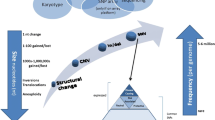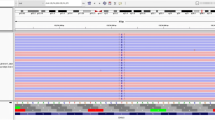Abstract
Epstein–Barr virus (EBV) is associated with several life-threatening diseases, such as lymphoproliferative disease (LPD), particularly in immunocompromised hosts. Some categories of primary immunodeficiency diseases (PIDs) including X-linked lymphoproliferative syndrome (XLP), are characterized by susceptibility and vulnerability to EBV infection. The number of genetically defined PIDs is rapidly increasing, and clinical genetic testing plays an important role in establishing a definitive diagnosis. Whole-exome sequencing is performed for diagnosing rare genetic diseases, but is both expensive and time-consuming. Low-cost, high-throughput gene analysis systems are thus necessary. We developed a comprehensive molecular diagnostic method using a two-step tailed polymerase chain reaction (PCR) and a next-generation sequencing (NGS) platform to detect mutations in 23 candidate genes responsible for XLP or XLP-like diseases. Samples from 19 patients suspected of having EBV-associated LPD were used in this comprehensive molecular diagnosis. Causative gene mutations (involving PRF1 and SH2D1A) were detected in two of the 19 patients studied. This comprehensive diagnosis method effectively detected mutations in all coding exons of 23 genes with sufficient read numbers for each amplicon. This comprehensive molecular diagnostic method using PCR and NGS provides a rapid, accurate, low-cost diagnosis for patients with XLP or XLP-like diseases.



Similar content being viewed by others
References
Young LS, Rickinson AB. Epstein–Barr virus: 40 years on. Nat Rev Cancer. 2004;4:757–68.
Hislop AD, Taylor GS, Sauce D, Rickinson AB. Cellular responses to viral infection in humans: lessons from Epstein–Barr virus. Annu Rev Immunol. 2007;25:587–617.
Taylor GS, Long HM, Brooks JM, Rickinson AB, Hislop AD. The immunology of Epstein–Barr virus-induced disease. Annu Rev Immunol. 2015;33:787–821.
Thorley-Lawson DA, Gross A. Persistence of the Epstein–Barr virus and the origins of associated lymphomas. N Engl J Med. 2004;350:1328–37.
Raab-Traub N, Flynn K. The structure of the termini of the Epstein–Barr virus as a marker of clonal cellular proliferation. Cell. 1986;47:883–9.
Neria BF, Inghirami G, Knowles DM, Neequaye J, Magrath IT, et al. Epstein–Barr virus infection precedes clonal expansion in Burkitt’s and acquired immunodeficiency syndrome-associated lymphoma. Blood. 1991;77:1092–5.
Jones JF, Shurin S, Abramowsky C, Tubbs RR, Sciotto CG, Wahl R, et al. T-cell lymphomas containing Epstein–Barr viral DNA in patients with chronic Epstein–Barr virus infections. N Engl J Med. 1988;318:733–41.
Andersson-Anvret M, Forsby N, Klein G, Henle W. Relationship between the Epstein–Barr virus and undifferentiated nasopharyngeal carcinoma: correlated nucleic acid hybridization and histopathological examination. Int J Cancer. 1977;20:486–94.
Sullivan J, Sullivan L. Epstein–Barr virus-associated hemophagocytic syndrome: virological and immunopathological studies. Blood. 1985;65:1097–104.
Palendira U, Rickinson AB. Primary immunodeficiencies and the control of Epstein–Barr virus infection. Ann N Y Acad Sci. 2015;1356:22–44.
Tangye SG, Palendira U, Edwards ESJ. Human immunity against EBV-lessons from the clinic. J Exp Med. 2017;214:269–83.
Seemayer TA, Gross TG, Egeler RM, Pirruccello SJ, Davis JR, Kelly CM, et al. X-linked lymphoproliferative disease: twenty-five years after the discovery. Pediatr Res. 1995;38:471–8.
Tangye SG. XLP: Clinical features and molecular etiology due to mutations in SH2D1A encoding SAP. J Clin Immunol 2014;34:772–9.
Coffey AJ, Brooksbank RA, Brandau O, Oohashi T, Howell GR, Bye JM, et al. Host response to EBV infection in X-linked lymphoproliferative disease results from mutations in an SH2-domain encoding gene. Nat Genet. 1998;20:129–35.
Sayos J, Wu C, Morra M, Wang N, Zhang X, Allen D, et al. The X-linked lymphoproliferative-disease gene product SAP regulates signals induced through the co-receptor SLAM. Nature. 1998;395:462–9.
Rigaud S, Fondanèche M-C, Lambert N, Pasquier B, Mateo V, Soulas P, et al. XIAP deficiency in humans causes an X-linked lymphoproliferative syndrome. Nature. 2006;444:110–4.
Ono S, Okano T, Hoshino A, Yanagimachi M, Hamamoto K, Nakazawa Y, et al. Hematopoietic stem cell transplantation for XIAP deficiency in Japan. J Clin Immunol. 2017;37:85–91.
Rusmini M, Federici S, Caroli F, Grossi A, Baldi M, Obici L, et al. Next-generation sequencing and its initial applications for molecular diagnosis of systemic auto-inflammatory diseases. Ann Rheum Dis. 2016;75:1550–7.
Nakayama M, Oda H, Nakagawa K, Yasumi T, Kawai T, Izawa K, et al. Accurate clinical genetic testing for autoinflammatory diseases using the next-generation sequencing platform MiSEq. Biochem Biophys Rep. 2017;9:146–52.
Izawa K, Martin E, Soudais C, Bruneau J, Boutboul D, Rodriguez R, et al. Inherited CD70 deficiency in humans reveals a critical role for the CD70–CD27 pathway in immunity to Epstein–Barr virus infection. J Exp Med. 2017;214:73–89.
Abolhassani H, Edwards ESJ, Ikinciogullari A, Jing H, Borte S, Buggert M, et al. Combined immunodeficiency and Epstein–Barr virus-induced B cell malignancy in humans with inherited CD70 deficiency. J Exp Med. 2017;214:91–106.
Kuehn HS, Ouyang W, Lo B, Deenick EK, Niemela JE, Avery DT, et al. Immune dysregulation in human subjects with heterozygous germline mutations in CTLA4. Science. 2014;345:1623–7.
Schubert D, Bode C, Kenefeck R, Hou TZ, Wing JB, Kennedy A, et al. Autosomal dominant immune dysregulation syndrome in humans with CTLA4 mutations. Nat Med. 2014;20:1410–6.
Greil C, Roether F, La Rosée P, Grimbacher B, Duerschmied D, Warnatz K. Rescue of cytokine storm due to HLH by hemoadsorption in a CTLA4-deficient patient. J Clin Immunol. 2017;37:273–6.
zur Stadt U, Rohr J, Seifert W, Koch F, Grieve S, Pagel J, et al. Familial hemophagocytic lymphohistiocytosis type 5 (FHL-5) is caused by mutations in Munc18-2 and impaired binding to syntaxin 11. Am J Hum Genet. 2009;85:482–92.
Côte M, Ménager MM, Burgess A, Mahlaoui N, Picard C, Schaffner C, et al. Munc18-2 deficiency causes familial hemophagocytic lymphohistiocytosis type 5 and impairs cytotoxic granule exocytosis in patient NK cells. J Clin Invest. 2009;119:3765–73.
Kreins AY, Ciancanelli MJ, Okada S, Kong X-F, Ramírez-Alejo N, Kilic SS, et al. Human TYK2 deficiency: mycobacterial and viral infections without hyper-IgE syndrome. J Exp Med. 2015;212:1641–62.
Untergasser A, Cutcutache I, Koressaar T, Ye J, Faircloth BC, Remm M, et al. Primer3-new capabilities and interfaces. Nucleic Acids Res 2012;40:e115
Stepp SE, Dufourcq-Lagelouse R, Le Deist F, Bhawan S, Certain S, Mathew PA, et al. Perforin gene defects in familial hemophagocytic lymphohistiocytosis. Science. 1999;286:1957–9.
Boztug H, Hirschmugl T, Holter W, Lakatos K, Kager L, Trapin D, et al. NF-κB1 haploinsufficiency causing immunodeficiency and EBV-driven lymphoproliferation. J Clin Immunol. 2016;36:533–40.
Salzer E, Cagdas D, Hons M, Mace EM, Garncarz W, Petronczki ÖY, et al. RASGRP1 deficiency causes immunodeficiency with impaired cytoskeletal dynamics. Nat Immunol. 2016;17:1352–60.
Schober T, Magg T, Laschinger M, Rohlfs M, Linhares ND, Puchalka J, et al. A human immunodeficiency syndrome caused by mutations in CARMIL2. Nat Commun. 2017;8:14209.
Acknowledgements
We thank the patients and their parents as well as the doctors who provided the samples. This study was supported by grants from the Ministry of Education, Culture, Sports, Science, and Technology of Japan, the Ministry of Health, Labour, and Welfare of Japan, and the Japan Blood Products Organization.
Author information
Authors and Affiliations
Corresponding author
Ethics declarations
Conflict of interest
We have no financial or other potential conflicts of interest to declare.
Electronic supplementary material
Below is the link to the electronic supplementary material.
About this article
Cite this article
Ono, S., Nakayama, M., Kanegane, H. et al. Comprehensive molecular diagnosis of Epstein–Barr virus-associated lymphoproliferative diseases using next-generation sequencing. Int J Hematol 108, 319–328 (2018). https://doi.org/10.1007/s12185-018-2475-6
Received:
Revised:
Accepted:
Published:
Issue Date:
DOI: https://doi.org/10.1007/s12185-018-2475-6




